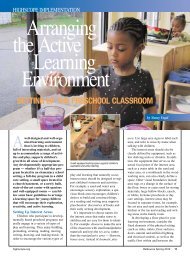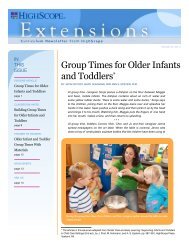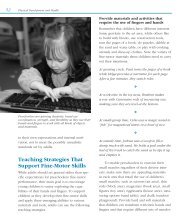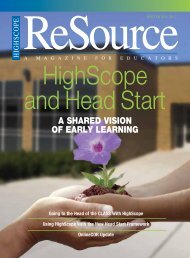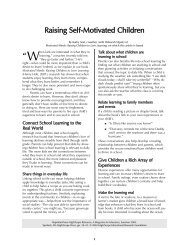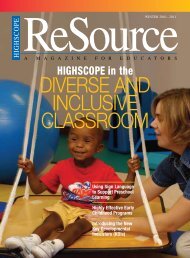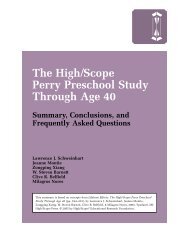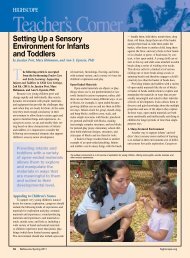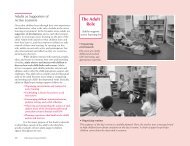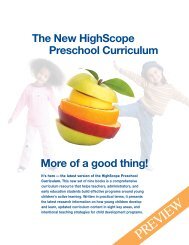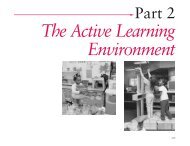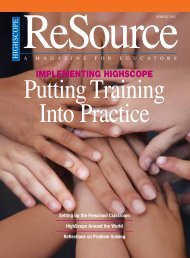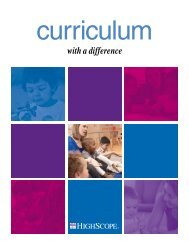Resource - High/scope In The Elementary Classroom
Resource - High/scope In The Elementary Classroom
Resource - High/scope In The Elementary Classroom
Create successful ePaper yourself
Turn your PDF publications into a flip-book with our unique Google optimized e-Paper software.
HigH/SCoPE ELEMENTARY<br />
rooms, with an emphasis on cooperative<br />
learning, feature group seating at tables<br />
in the various interest areas. individual<br />
work areas are also available for quiet,<br />
independent work. <strong>The</strong>se individual<br />
areas may include a space in the reading<br />
area or at the teacher’s desk, or students<br />
simply may be encouraged to take clipboards<br />
to quiet areas. Children’s work<br />
places in each of the learning areas<br />
serve a dual function as a place where<br />
students can accomplish their work and<br />
as a space where the materials in that<br />
particular area can be explored by all<br />
children during plan-do-review.<br />
Wall Displays<br />
<strong>The</strong> walls of traditional classrooms<br />
typically feature commercially-made<br />
posters, precut designs, and other readymade<br />
displays purchased by teachers<br />
for their instructional and decorative<br />
value. in a <strong>High</strong>/Scope setting, teacherprepared<br />
bulletin boards are limited to<br />
messages for children, information for<br />
parents, and weekly schedules. <strong>The</strong> classroom<br />
becomes instead a representation<br />
of children’s learning and discoveries.<br />
Teachers create a print-rich environment,<br />
displaying student writing as well<br />
as labels, important messages, group<br />
writing samples, and schedules, because<br />
students learn to read by trying to make<br />
sense of print they encounter in their<br />
everyday activities. in addition to featuring<br />
lots of print, the walls become<br />
covered with children’s creations — art-<br />
<strong>High</strong>/Scope classrooms<br />
emphasize<br />
cooperative learning<br />
by featuring<br />
group seating at<br />
tables in the various<br />
interest areas.<br />
work, science, and math projects, for<br />
example — and photographs of the<br />
children at work time with written descriptions<br />
of their activities below. <strong>The</strong><br />
students themselves select the pieces of<br />
their work they would like to display<br />
rather than the teacher choosing the<br />
“best” or “neatest.” Allowing children<br />
the opportunity to display work that<br />
is meaningful to them leads to their increased<br />
self-esteem and sense of belonging<br />
in the classroom.<br />
<strong>In</strong> a <strong>High</strong>/Scope elementary classroom, shelves, containers, and baskets are clearly labeled and placed<br />
within children’s reach.<br />
Content Workshops and<br />
Curriculum<br />
Setting up the classroom according<br />
to <strong>High</strong>/Scope principles better enables<br />
teachers to meet the curriculum requirements<br />
of their state or province using a<br />
model called “content workshops.” <strong>The</strong>se<br />
are small-group instructional workshops<br />
planned by teachers around specific<br />
content in the major subject areas of the<br />
curriculum. Teachers introduce content<br />
workshops by giving a brief lesson on a<br />
particular topic or subject; then children<br />
move to table groups or other suitable<br />
places in the classroom, such as the reading<br />
area or carpet area, and begin to implement<br />
what they’ve learned by using<br />
and manipulating related materials.<br />
What does a content workshop look<br />
like? Three or four small groups of<br />
children (assuming a classroom size<br />
of approximately 20 students with one<br />
teacher) work at separate stations and are<br />
engaged simultaneously in curriculumrelated<br />
activities using various materials.<br />
<strong>The</strong> children then rotate among the tables<br />
in order to experience all activities. <strong>The</strong><br />
teacher’s role during a content workshop<br />
is similar to a teacher’s role in a pre-K<br />
small-group time. Specifically, the teacher<br />
focuses on the children, assesses skill<br />
and knowledge, challenges, extends, and<br />
encourages learning through open-ended<br />
questions and authentic conversation,<br />
sharing control with students.<br />
A math content workshop, for example,<br />
might include estimation of length as<br />
the curriculum focus. Following a brief<br />
discussion with the whole group about<br />
the concept, the teacher would then have<br />
prepared activities at separate table<br />
groups. instructions for these activities<br />
would be given verbally, as well as<br />
visually or in written form, according to<br />
the developmental level of the students.<br />
Table group “A” may have a variety of<br />
standard measuring tools, including<br />
yardsticks, rulers, and measuring tapes<br />
for students to explore the classroom<br />
environment. <strong>The</strong> focus for this group<br />
www.high<strong>scope</strong>.org ReSource Fall/Winter 2008 13



